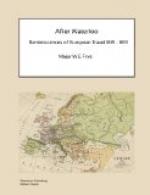Parma will ever be renowned in history as the birthplace of Caius Cassius, the Mend and colleague of Brutus.
The Empress Maria Louisa lives here in the Ducal Palace, which is a spacious but ornamental edifice. She lives, ’tis said, without any ostentation. Out of her own states, her presence in Italy would be attended with unpleasant consequences to the powers that be, on account of the attachment borne to Napoleon by all classes of society; and it is on this account that on her last visit to Bologna she received an intimation from the papal authorities to quit the Roman territory in twenty-four hours. We next passed thro’ St Hilario and Reggio and brought to the evening at the village of Rubbiera. At St Hilario is the entrance into the Duke of Modena’s territory, and here we underwent again &n examination of trunks, as we did both on entering and leaving the territory of Maria Louisa.
Reggio is a large walled city, but I had only time to visit the Cathedral and to remark therein a fine picture of the Virgin and the Chapel called “Capella della Morte.” Reggio pretends to the honour of having given birth to the Divine Ariosto:
Quel grande che canto l’armi e gli amorl,
as Guarini describes him, I believe. The face of the country from Parma to Reggio is exactly the same as what we have passed thro’ already.
The next day (20 August) we passed thro’ Modena, where we stopped to breakfast and refresh horses. It is a large and handsome city, the Ducal Palace is striking and in the Cathedral is presented the famous bucket which gave rise to the poem of Tassoni called La Secchia rapita. An air of opulence and grandeur seems to prevail in Modena.
At Samoggia we entered the Papal territory and again underwent a search of trunks. Within three miles of Bologna a number of villas and several tanneries, which send forth a most intolerable odour, announce the approach to that celebrated and venerable city. On the left hand side, before entering the town, is a superb portico with arcades, about one and a half miles in length, which leads from the city to the church of San Luca. On the right are the Appennines, towering gradually above you. Bologna lies at the foot of these mountains on the eastern side and here the plain ends for those who are bound to Florence, which lies on the western side of the vast ridge which divides Italy. We arrived at Bologna at half-past seven in the evening, and here we intend to repose a day or two; I shall then cross the Appennines for the first time in my life. A reinforcement of mules or oxen is required for every carriage; from the ascent the whole way you can travel, I understand, very little quicker en poste than with a vetturino. We are lodged at Bologna in a very comfortable inn called Locanda d’Inghilterra.
BOLOGNA, 22d August.




